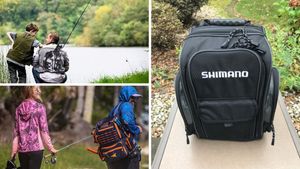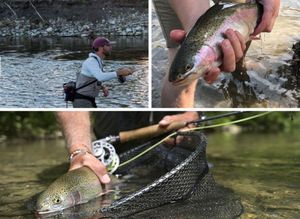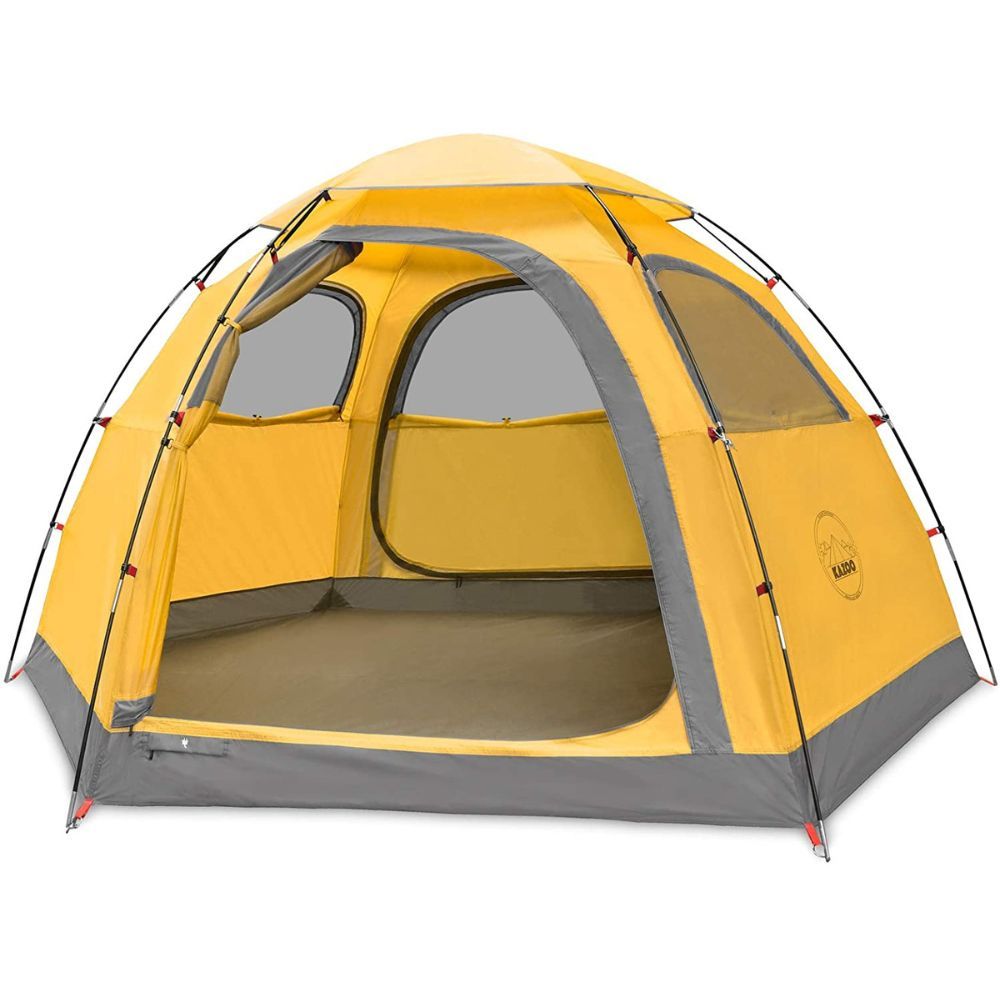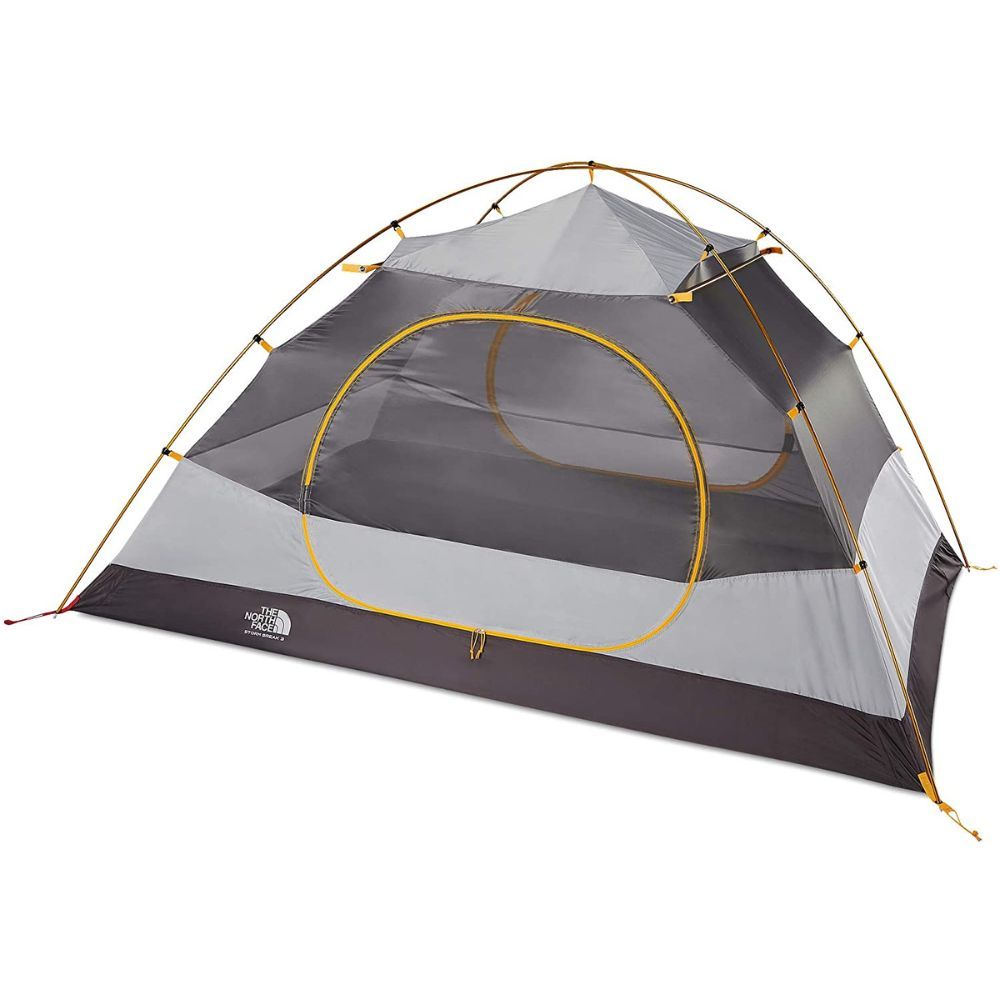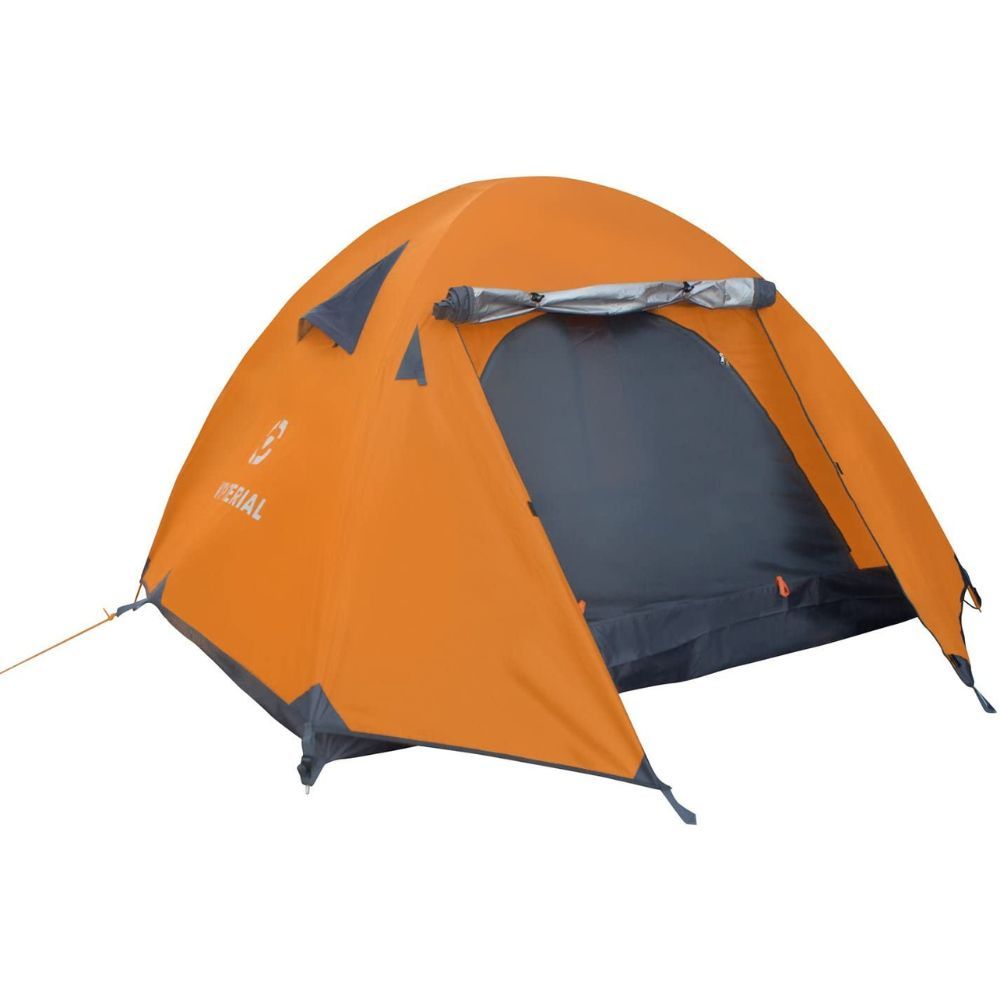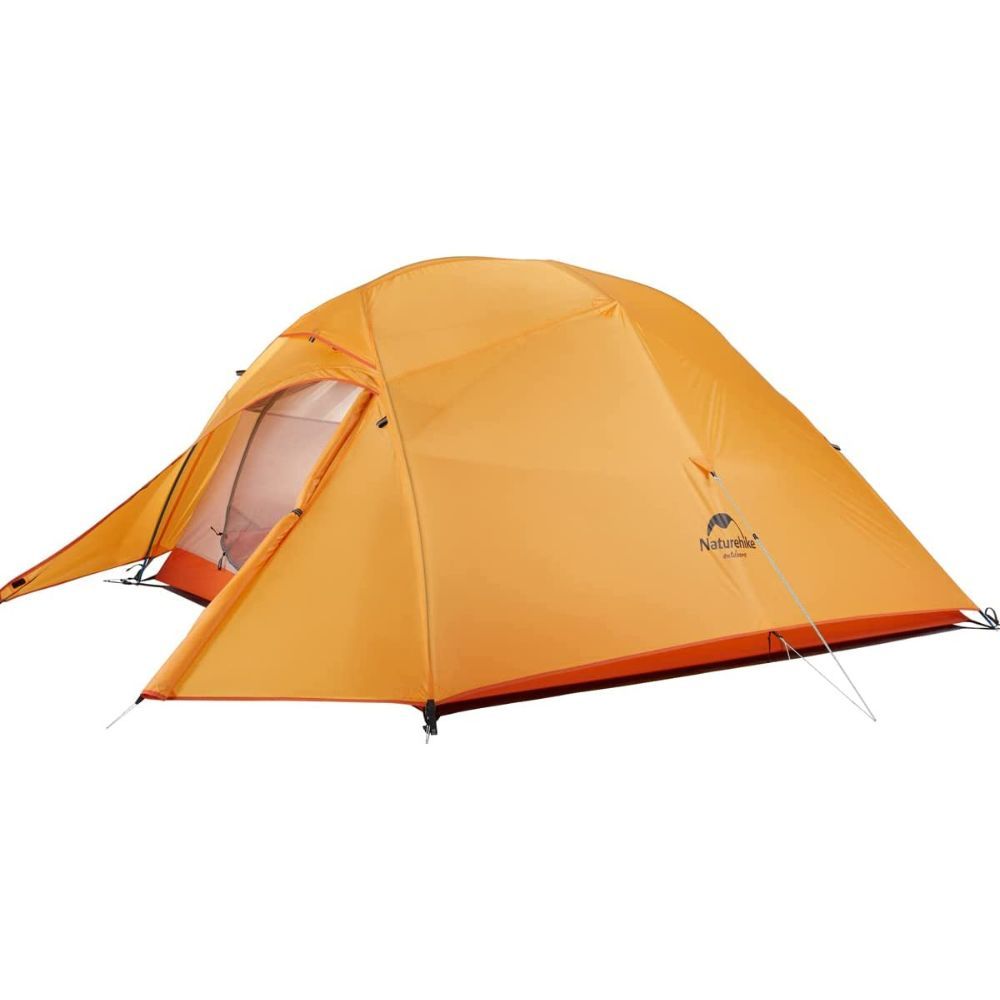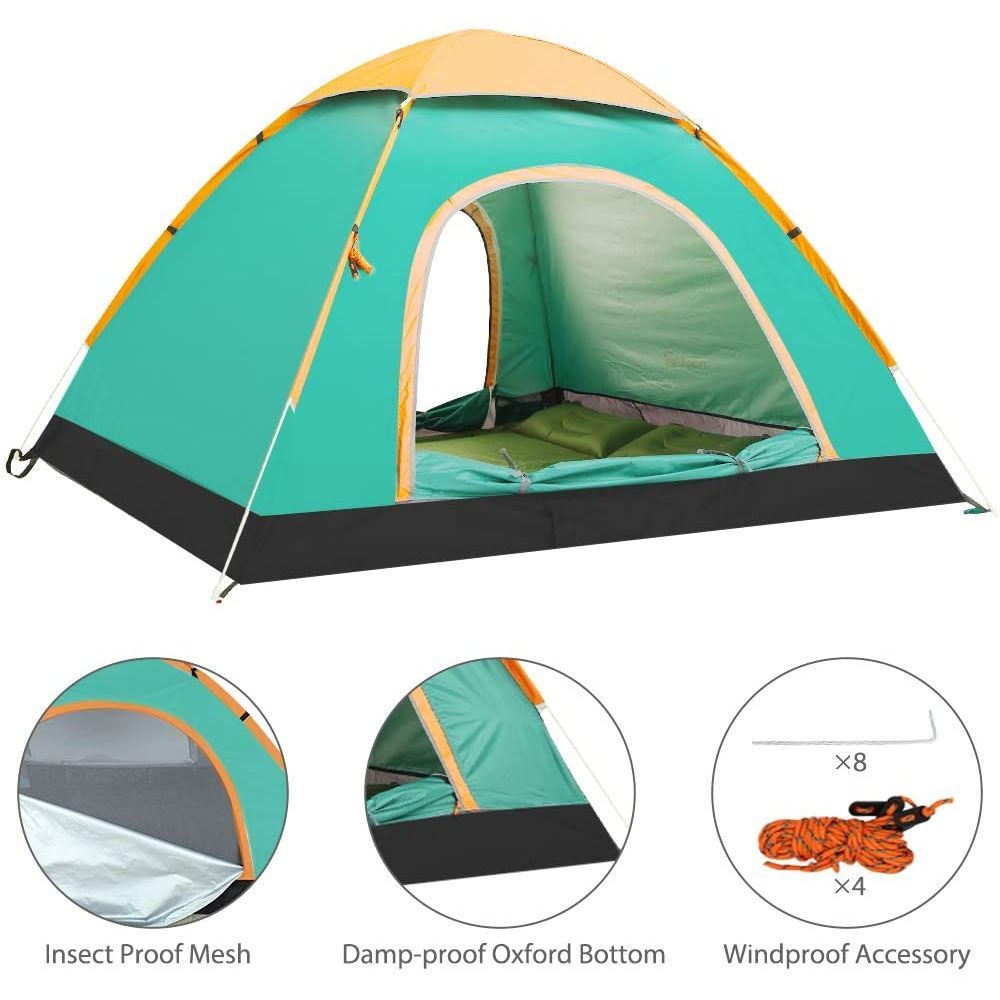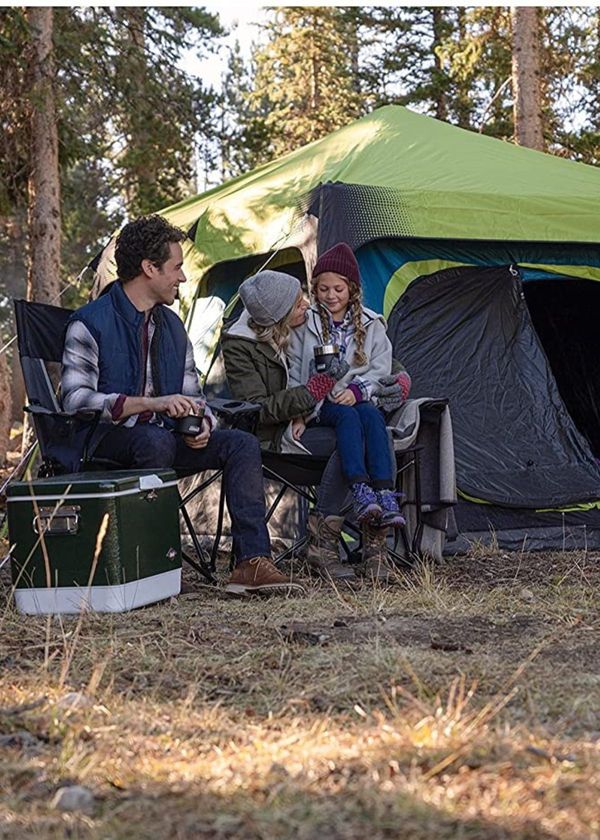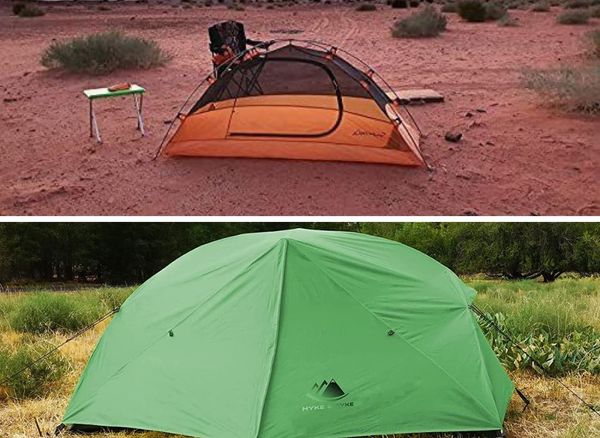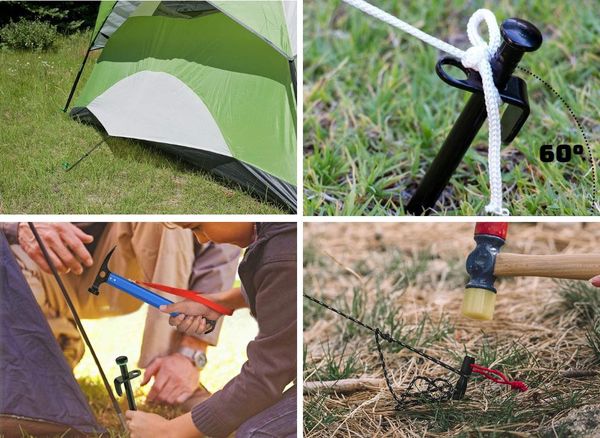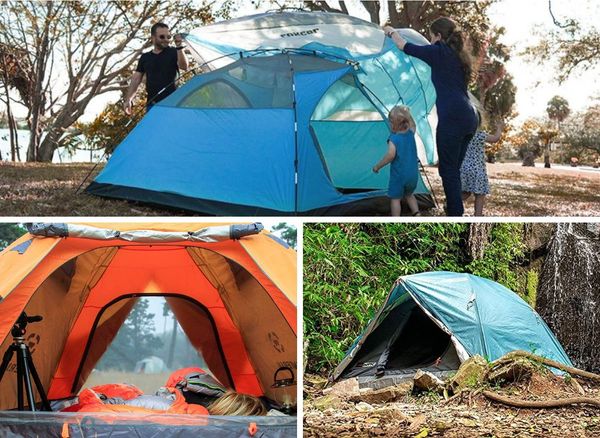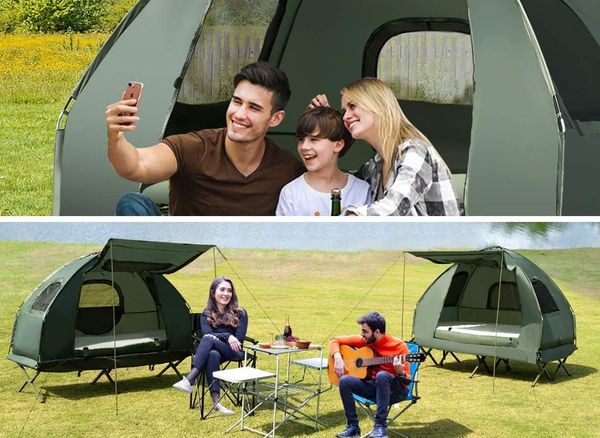Looking for the best three person tent?
You've come to the right place! In this article, we will review some of the best backpacking tents on the market and provide you with a buying guide to help you choose the perfect one for your needs.
Whether you are looking for something for car camping or for your next backpacking trip, we have got you covered. So, without further ado, let's get started!
How We Choose
You want to go camping with your friends, but don't know which three person tent is best for you.
With so many options it can be difficult to know which one is best for your needs. You might not even know what to look for when choosing a three person tent.
We're here to help! In this guide we'll walk you through the different features of three person tents and teach you how to choose the perfect one for your needs.
Whether you're looking for a budget-friendly option or something that will keep you comfortable in any weather, we've got you covered.
Products We Reviewed
Why We Love It
Looking for an affordable, spacious, and convenient family camping tent? Look no further than the KAZOO Outdoor Camping Tent! This family camping tent provides excellent protection from the sun, rain, and wind, making it perfect for all your outdoor activities.
With a spacious room (82 x82 x53 inches) and two zippered doors, this tent is ideal for family beach days or camping trips. Plus, one person can easily set it up in just three minutes!
What You Should Know
The KAZOO Outdoor Camping Tent is designed to comfortably fit 3 people. Its double layer structure with waterproof 210T Rip-stop polyester offers a reliable and durable shield against bad weather conditions, so you can enjoy your time outdoors no matter what the weather is like.
This 3 person tent also comes with 2 large and dual zipper doors for easy entry and smooth closure, as well as 2 windows and ceiling vents that are designed to provide excellent ventilation.
High quality details include smooth and reliable SBS dual zippers, mesh interior pockets, incredibly durable rip-stop fabric materials, full-coverage rainfly and firm lightweight structure.
This KAZOO Outdoor Camping Tent is perfect for family camping trips or any outdoor adventure!
Why We Love It
The North Face Stormbreak 3 Camping Tent is the perfect choice for your next outdoor adventure.
This easy-to-pitch tent can accommodate up to three people, making it ideal for couples or small families. The large doors provide easy access and a great view of your surroundings, while the ventilation system ensures you'll stay cool and comfortable in warm weather.
The Stormbreak 3 is also equipped with a rain fly for added protection against the elements.
Whether you're headed to the mountains or the beach, this tent will help you make the most of your time outdoors.
What You Should Know
A fully seam-taped canopy and floor help to enhance durability and waterproofing, making this tent ideal for any camping trip.
The 75D polyester taffeta canopy and 68D polyester floor are both tough and lightweight, while the 40D polyester mesh provides excellent ventilation.
The two doors and twin-zip vestibules make it easy to get in and out, and the high-low ventilation system keeps the air flowing.
With a weight of less than 7 pounds, this tent is easy to carry and set up.
Whether you're an experienced camper or just starting out, this tent will help you enjoy the great outdoors.
Why We Love It
Looking for a quick, easy, and reliable tent for your next camping trip? Look no further than the Winterial Three Person Lightweight 3 Season Tent!
This tent is perfect for three people and can be set up in just five minutes. Simply stake down the corners of the tent and install the two aluminum poles and you're ready to go.
Plus, when you're done camping, everything packs up nicely into the included travel bag. So don't miss out on your next outdoor adventure - be sure to bring along the Winterial Three Person Lightweight 3 Season Tent!
What You Should Know
The Winterial Three Person Lightweight 3 Season Tent is the perfect tent for Spring, Fall and Summer.
It features an internal pocket, waterproof rainfly and stitching, a durable waterproof floor, and all-metal poles and stakes.
The tent also has a convenient internal pocket for storage of small items, large double-layered doors for easy access, and includes a rainfly, 2 x aluminum poles, 13 ground stakes and 4 guy lines.
The Winterial Three Person Lightweight 3 Season Tent is lightweight and compact, weighing only 4.4lbs, and measuring 24" x 4.5" x 4" when packed for transport. When set up, the tent measures 82" x 64" x 46", making it the perfect size for backpacking or camping.
The tent is made with 190T Polyester fabric that is durable and resists tearing. The all-metal poles and stakes are also sturdy and will withstand strong winds.
The Winterial tent also has a waterproof floor that prevents moisture from seeping in and damaging your gear.
Whether you're looking for a tent for hiking, camping or backpacking, this tent is the perfect choice!
Why We Love It
Looking for a spacious and comfortable backpacking tent that won't weigh you down? Naturehike's Cloud-Up 3 person tent is perfect for your next adventure!
Weighing in at just over 5 pounds, this tent is ultra-lightweight and easy to carry, making it ideal for backpacking trips. Yet despite its small size, the Cloud-Up tent offers plenty of room for three people to sleep comfortably.
The waterproof and breathable canopy provides protection from the elements, while the mesh inner tent offers excellent airflow to keep things cool and comfortable inside.
With an easy-to-use setup and plenty of space for all your gear, the Naturehike Cloud-Up 3 person tent is perfect for your next outdoor adventure!
What You Should Know
The Cloud-up is an excellent tent for anyone who wants to be prepared for extreme weather conditions.
The weatherproof material and factory-sealed seams will keep you dry in even the heaviest of rainstorms, and the high-quality details like smooth YKK zippers and durable rip-stop fabric will ensure that your tent can withstand even the most intense adventures.
Plus, at less than six pounds, it won't weigh you down when you're on the go.
Whether you're an experienced camper or just looking for a reliable tent to take on your next adventure, the Cloud-up is a great option.
Why We Love It
Looking at lightweight tents that are quick and easy to set up, but still offers plenty of space for you and your camping gear? Look no further than the Ubon 2/3 Person Lightweight Instant Tent.
This instant tent comes in two different sizes, so you can choose the perfect option for your needs.
Plus, it offers ample space for 2-3 people with a peak height of 43/53 inches. And, it has two doors with mesh which keeps the interior fresh and reduces air condensation inside of the tent to keep the environment pleasant.
So, whether you're looking for a quick and easy option for your next camping trip or you need a spacious tent that's easy to set up, the Ubon 2/3 Person
What You Should Know
Tired of fumbling with tent poles and struggling to put up a shelter before dark? Then this Ubon Instant pop-up tent is definitely for you! Just take it out of the bag, pull out the two white locks and it will pop up automatically.
The mesh window provides excellent ventilation and allows you to enjoy the outdoor views. The extra storage bag lets you keep your items organized and nearby.
The 190T Polyester breathable fabric with silver coating will shelter you from the sun's heat.
It weighs less than 4 pounds, so it's perfect for camping, hiking or fishing trips.
Buyers Guide
Tent Design
Doors
A single door tent has the entrance located on the front of the tent. That means that if you want to go out to 'see the stars' at night you may end up crawling over your sleeping companions. In some tent designs the highest part of the tent is close to the door which makes for a larger vestibule area.
A second door on the tent will result in less commotion in the night and may well be the deciding factor in which tent to choose.
The second door also encourages a cross breeze providing better ventilation.
However, a second door means more zippers, more complex cutting and assembling and, generally, more weight.
Vestibule
The vestibule is a covered area outside of your tent that can be used for storing outdoor gear and adding space. It's not sealed in like the body, so it provides extra shelter from bad weather when you want to close up shop inside with all those nice cozy things stored away!
Vestibules on tents with a single door are generally larger which provides more space for storing your gear outside the tent. The downside is that they can be too large which can make it difficult to close up from inside the tent.
Vestibules on tents with two doors are usually smaller. They do, however, give you more flexibility on where you might store your gear and get into and out of the tent.
Freestanding or Non-Freestanding
Tents that are not freestanding rely on tent poles or trekking poles to keep their shape and are generally set up with the use of stakes. Freestanding tents, on the other hand, do not require stakes to remain upright and come with tent poles already attached.
Freestanding tents are usually very easy to setup - take them out of the stuff sack and they pop up into shape without the need to stake any point down. They can be placed just about anywhere and offer better structural integrity in bad weather. By their design you often get more interior space but you pay for that by having a bulkier and heavier tent.
Ventilation
When the air inside a tent is humid, condensation can develop and damage your gear. When warm air from within the shelter comes into contact with the colder material of the rainfly, condensation forms. Before it has a chance to condense, warm, moist air should be removed from the tent through excellent ventilation.
The effectiveness of a tent's design in enabling air exchange is essential. Double-walled tents (tents with a separate body and rainfly) are better at preventing condensation. The body is more porous since it is composed of mesh. There is extra space between the body and the rainfly, allowing air to escape from within the structure.
The body and rainfly are joined into a single layer of material in single-wall tents. This means less mesh and greater condensation possibilities since there is less area for warm air to escape.
To prevent condensation you should position your then where it will capture any prevailing breeze. Avoid as best you can setting up camp next to a body of water or swampy areas. Keep wet gear and any cooking outside of the tent.
Storage Pockets
Storage pockets are a wonderful way to store and arrange your gear. These compartments are ideal for storing items that are easily available, such as sun screen, glasses, or a phone.
If your camp is going to be in the same spot for a while then storage pockets allow you to unpack and organize your gear better.
If you’re going to be on the move a lot, packing and unpacking every day, then they are less useful.
Other Considerations
Are you backpacking, car camping, or both? How you are camping is a critical issue in choosing the right tent for you. If you are carrying everything on your back then you need to look to the weight and ease of use. If you are putting everything in the trunk of your car then you can opt for a bigger and more comfortable tent.
Weight
If you are camping out of your car then the weight of the tent is not critical. But when backpacking you need to focus on the actual weight of the tent and components you will need for that trip. The advertised packed weight (everything that came with the tent) and trail weight (the minimum amount needed to setup under ideal conditions) will mark the upper and lower bounds of what you will actually be carrying.
Shoot for an actual weight of five to six pounds. More than that gets to be too heavy for a backpacking rig.
Packability
For a backpacker the size of the tent in it's stuff sack is crucial. Smaller pack size means more room for other gear. If there are two or more in your party the load can be split up between you. One person can take the tent while the other takes the ground tarp and tent poles.
Material
The materials used in a tent have a significant impact on weight, durability, and weatherproofing. Nylon and polyester fabric are the most common materials used and come in various weights. In areas that require more protection, the cloth is thicker throughout the high abrasion zones and thinner along the edges that need less coverage.
Nylon has the best strength to weight ratio. It is durable, relatively inexpensive and highly resistant to cuts and abrasion. It is adversely affected by UV exposure and requires regular maintenance to maintain waterproofing.
Cuben Fiber is an ultralight material that is strong, waterproof, and resistant to UV degradation. It is however quite susceptible to rips, tears and abrasion and much more costly.
Walls
Cold weather camping requires a different type of construction that what is used in a 3 season tent. Camping in spring, summer and fall means you want a tent with plenty of ventilation which is supplied by mesh walls. These tents can be single or double walled, often depending on the weather conditions you might encounter.
Cold weather tents on the other hand will have solid walls with little mesh, thicker fabric that is better at retaining heat and protecting you from the elements and a stronger supporting structure (poles, guy wires, etc.) to meet extreme weather conditions.
Accessories:
There are tons of addons you can buy to enhance your tent and make it your own. Keep these items in mind in shopping for a new tent.
A ground cloth is a protective layer placed beneath your tent, providing an added layer of protection against abrasive ground and wet situations. Many tents include specially designed components that may be purchased separately. The popular blue tarp is a budget-friendly, basic version.
Tent stakes are simple to replace, and many varieties of material are used, ranging from light titanium to durable steel. There are also sand and snow-specific stakes available. Stakes aren't included with some tents.
At times, when conditions are windy, you'll need to use a guy line. These special lines assist in keeping your tent from blowing away in the wind and provide more stability. Each guy line requires its own stake. Extra points if your guy line is bright so that people don't trip over them at night.
Repair kits are pre-made patch kits for mending holes in the tent fabric, repairing broken poles, and stopping leaks. If you're in a bind, duct tape will always come to the rescue.
Waterproofing and UV Protection
Unless you are planning on spending big bucks for a Cuben Fiber tent you will need to be aware of the need to waterproof your tent. Nylon and polyester fiber tents absorb water if not treated properly.
Most tents include a water-resistant topcoat pre-applied. However, over time, UV rays, dust, and grime will harm your tent's ability to shed water.
When this happens, it's a good idea to renew the water-resistant capabilities of your shelter. To help it shed water like new, seal the seams of your tent and apply a waterproofing spray.
UV damage can be an issue if you frequently pitch your tent in high UV environments like deserts, on snow, and at heights. Nylon and polyester cloth are weakened by UV exposure.
Three Person Tent FAQ
You want to go camping with your friends, but don't know which three person tent is best for you.
With so many options it can be difficult to know which one is best for your needs. You might not even know what to look for when choosing a three person tent.
We're here to help! In this guide we'll walk you through the different features of three person tents and teach you how to choose the perfect one for your needs. Whether you're looking for a budget-friendly option or something that will keep you comfortable in any weather, we've got you covered.
What is the best 3 man tent to buy?
There are a lot of great three-man tents on the market, and it really depends on your budget and what type of camping you plan on doing. In addition to the tents we have reviewed here there are a few good options.
If you're looking for an affordable option, I would recommend the Coleman Sundome 3-Person Tent. It's waterproof and has a roomy interior, and, compared to other backpacking tents, it's easy to set up and take down.
If you're willing to spend a bit more money, I would recommend the North Face Bastion 3-Person Tent. It's made with sturdy materials that can withstand harsh weather conditions, and it has a spacious interior with plenty of headroom. Plus, it comes with a free rain fly.
Whatever tent you choose, make sure to read reviews and do your own research.
What is a good weight for a 3 person backpacking tent?
There is no one-size-fits-all answer to this question, as the weight of a three person backpacking tent will vary depending on the type of tent and the materials used in its construction. However, as a general rule, you can expect a three person backpacking tent to weigh between four and six pounds.
When choosing a three person backpacking tent, it's important to consider the weight and size of the tent when packed up, as well as the amount of space it provides inside. It's also important to make sure that the tent is made from lightweight materials that will be easy to carry on long hikes.
How big is a 3 person tent?
A 3 person tent is usually around 10-12 square feet, or about 90 inches by 108 inches. This size will accommodate three average-sized people, but might be a little tight for larger individuals.
Some tents are designed to hold more people by providing additional space in the form of an extra vestibule area that can be used for storage, while others sacrifice interior space in order to make the tent lighter and easier to carry.
So when shopping for a 3 person tent, it's important to consider how important floor space is to you, and whether you're willing to trade off some of that space in order to have a lighter and more portable option.
What is the best waterproof rating for tents?
There is no definitive answer to this question as it depends on a number of factors, including the intended use of the tent, the climate in which it will be used, and the budget.
However, here are some general guidelines to help you choose the best waterproof rating for your needs.
If you plan to use your tent primarily in milder weather conditions (e.g., spring and fall), then a waterproof rating of 800-1000mm will suffice. This range provides good protection against rain and snow, but is not recommended for prolonged exposure to severe weather conditions.
If you camp in harsher conditions or spend extended periods of time outdoors in all kinds of weather, then a waterproof rating of 1500-2000mm is ideal. This range offers excellent protection against all types of precipitation, including heavy rain and snow.
For the absolute best protection against the elements, look for a tent with a waterproof rating of 3000mm or higher. This range is typically only necessary for mountaineers and other extreme outdoor enthusiasts who camp in extreme conditions.
When choosing a waterproof rating for your tent, it is also important to consider the type of fabric used. Polyester and nylon are the most common materials used in tents, and they each have their own characteristics.
Polyester is more durable than nylon and is less likely to tear or rip. However, it is not as breathable as nylon and can feel clammy in warm weather conditions.
Nylon is more breathable than polyester and is a good choice for summer camping trips. However, it is not as durable as polyester and is more likely to tear or rip.
Both polyester and nylon fabrics can be treated with waterproofing sprays or seam sealants to improve their water-resistant properties.
How much should I spend on a backpacking tent?
Backpacking tents can vary significantly in price, so it really depends on your budget and what kind of features you're looking for.
You can find basic models for around $100, while more advanced models with more bells and whistles can run upwards of $500.
Some things to keep in mind when shopping for a backpacking tent include weight, capacity, seasonality, and durability.
For example, if you plan on doing a lot of backpacking in wet or cold conditions, you'll want to make sure you get a tent that's waterproof and has good ventilation.
Conversely, if you're primarily backpack during the summer months, weight and packability may be more important factors for you.
How should I cut my weight for backpacking?
There is no one-size-fits-all answer to this question, as the best way to lose weight for backpacking will vary depending on your individual situation and goals. However, some general tips on how to lose weight for backpacking include:
1) Cut out processed foods and sugary drinks. These are high in calories and low in nutritional value, and they can quickly add up to excess weight.
2) Eat plenty of fresh fruits and vegetables. These are high in fiber and nutrients, and they will help you feel full without consuming too many calories.
3) Exercise regularly. This not only helps you burn calories, but it also strengthens your muscles which can help you carry more gear when backpacking.
What should I look for when buying a tent?
There are a few things you should keep in mind when shopping for camping tents:
1. The size of the tent. Make sure to consider how many people you need to accommodate, as well as how much gear you'll be bringing along.
2. The weight of the tent. If you're planning on backpacking, you'll want to make sure your tent is light enough to carry easily. The best backpacking tents generally weigh less than those intended for car camping.
3. The type of material the tent is made from. Some materials, like canvas, make for a more durable tent than others and can better withstand harsher weather conditions.
4. The price of the tent. Tents can range widely in price, so it's important to set a budget before you start shopping.
How much does an average camping trip cost?
It really depends on how lavish of a trip you want. If you're just looking to buy a tent and some supplies, it can be as cheap as $50. But if you want all the bells and whistles (like an RV or cabin rental), it can cost well over $1,000.
No matter what route you go, though, there are a few key expenses that are pretty much unavoidable: camping equipment, food, transportation, and admission fees (if any). So it's important to budget for these items accordingly.
And don't forget about extras like bug spray, sunscreen, toiletries, etc., which can add up quickly.
How do you shave while backpacking?
When you're out on the trail, there's no need to feel self-conscious about your appearance. However, if you want to shave while backpacking, there are a few things to keep in mind.
First, you'll need to find a place where you can set up your shaving kit. If you're able to find a flat spot near a stream or lake, that's ideal.
Make sure you have everything you need within reach so that you don't have to move around too much while shaving. It's also important to safely dispose of any hair that accumulates while shaving.
Next, it's time to gather your supplies. You'll need soap, water (either from a bottle or boiled), a razor, and shaving cream. If you have sensitive skin, it might be a good idea to bring along an aftershave lotion as well.
Now that you have everything you need, it's time to start shaving. Start by wetting your face with either soap and water or shaving cream. Be sure to avoid any cuts or scrapes that could become infected. Next, use your razor to carefully remove any hair. Rinse your face with clean water when you're finished.
If you don't have access to shaving cream, there are a few other options you can use. One is to make a paste out of baking soda and water.
Another is to use conditioner instead of shaving cream. Whichever method you choose, be sure to rinse your face well when you're finished.
Now that you know how to shave while backpacking, there's no need to let your appearance suffer on the trail.
What is considered ultra light backpacking?
Ultra light backpacking is all about carrying the minimum amount of gear and supplies necessary to enjoy a hiking trip. This might include a very lightweight backpack, an ultralight tent, basic cooking supplies, and a minimal first-aid kit.
Ultra light backpackers typically choose to hike with less weight on their backs, which can make for a more comfortable journey.
Best Three Person Tent for You
So, what’s the best 3 person tent? After hours of research and reading verified customer reviews on Amazon, we have determined that the best camping tent for your needs is the – Ubon 2/3 Person Lightweight Instant Tent. It has a good mix of features at an affordable price point, making it perfect for budget-minded campers.
If you are looking for a more luxurious option, we suggest checking out the KAZOO Outdoor Camping Tent 2/4 Person Waterproof Camping Tent.
Finally, if you are in need of a compact and lightweight tent for backpacking or solo camping trips, take a look at the Winterial Three Person Lightweight 3 Season Tent. Thanks for following along with our guide!

